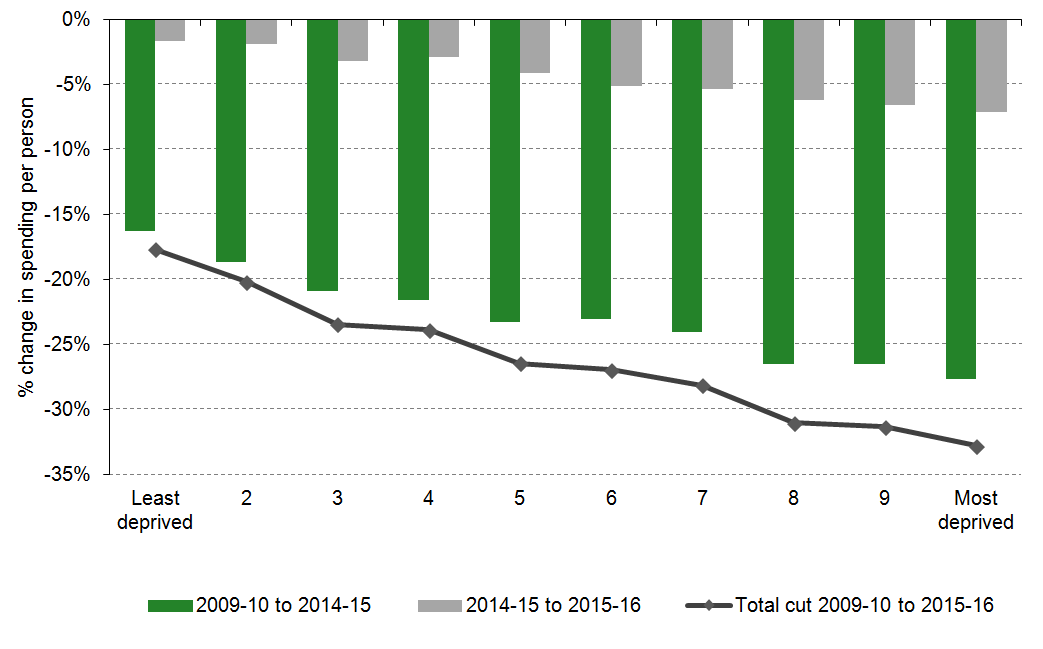This commentary was published in Public Sector Executive magazine online on 23 April 2015 and in the April/May 2015 print edition and is reproduced here in full with permission.
Local government spending in England has been cut by more than a fifth over this Parliament, as the Coalition government cut grants to local authorities as part of its fiscal consolidation. But cuts to local government spending have not been equally tough everywhere. It is the most deprived councils that have lost the most, and the same authorities are likely to be most affected by future cuts.
Nationally, the cuts to local government spending have been similar in magnitude to those faced by Whitehall departments, other than those that have been explicitly protected – the NHS, schools and overseas aid. Local government spending was cut by 23% per person in real terms between 2009–10 and 2014–15. The measure of spending used here excludes education spending, since this takes place mostly (and increasingly) outside local control, and also excludes the additional responsibilities for public health and social care that local governments were given during the period.
Not all local authorities have been affected equally. Areas with the highest levels of deprivation on average saw the largest percentage cuts to spending. The most deprived tenth of councils saw spending cuts of 28% per person, while the least deprived tenth cut spending by 16% per person (see graph).
Real terms cuts to local government net service spending per person, by deprivation level

Source: Authors’ calculations using Department for Communities and Local Government data on local government expenditure out-turns and expected spending power in 2015–16.
Why have more deprived local authorities seen the largest cuts? Councils fund spending through a mix of council tax revenues and grants from central government, but differ in the relative importance of these revenue sources. While council tax revenues per person declined only slightly over the last five years, central government grants have been cut by more than a third. The most deprived councils saw on average the same percentage cuts to grants as the least deprived, but they are much more reliant on this source of income. Therefore, this resulted in a greater cut to their overall spending.
The pressures on local government spending are likely to continue in the next Parliament. However, exactly how tight the squeeze will be is likely to depend on who forms the next government. There are significant differences between the spending plans of the main UK political parties. The largest difference arises from the fact that the Conservatives have said that they want to achieve an overall surplus, while Labour and the Liberal Democrats have said that they would be willing to borrow to cover investment spending. This alone could allow Labour to spend (and borrow) up to around £30bn more each year by the end of the next Parliament than the Conservatives, for example.
But the pattern of more deprived local authorities seeing the largest cuts looks set to continue. The way grants are allocated between councils was simplified in 2013. Under the new system all councils see exactly the same percentage cut to a core element of their grants each year. Therefore, the most deprived local authorities will see the same percentage cuts to their grants as the least deprived, and again this will amount to a higher overall budget cut. This can be seen in the planned cuts for 2015-16 in the graph. The most deprived local authorities face further real-terms cuts of 7.1% per person on average; the least deprived just 1.7%.
Under the current funding system, it is not just the most deprived councils that lose out most from cuts to grants. The new grant allocations also will not take into account population growth over the next five years. Areas with higher population growth will see grants per person fall faster than other areas. The effects could be felt particularly in London: the eight councils expected to see the fastest population growth over the next five years are all London boroughs, with forecast population growth ranging from 7.6% to 10.8%, compared to 3.6% on average across England.
Can local governments turn to other revenue sources to offset the cuts to their grants? Councils have been discouraged from raising council tax rates over this Parliament and have required a local referendum to increase rates above a 2% cap. Easing this cap could allow councils to raise more revenues themselves. Yet this would be of least benefit to the councils facing the greatest cuts, since they tend to have the lowest local-revenue-raising capacity.
For future cuts to be more evenly spread across local authorities, more fundamental reform to the way central government grants are allocated would be required.





